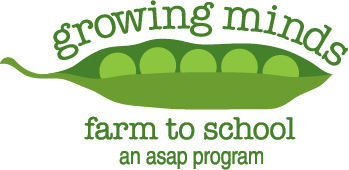In middle and high school, farm to school lends itself to looking at a broader view of agriculture. It often includes topics such as industrial vs. small scale food systems, public health, environmental impacts of agriculture, and food equity issues. This is a great time to prepare students to be educated food consumers and understand the impacts of their food purchasing decisions.
The resources linked below were not developed by the Growing Minds program. They were compiled by a member of our team who is a former high school science teacher and represent what she considers to be the best of what is available.
Curricula
Garden Genetics: Teaching with Edible Plants: Teach genetics, ecology, and examine ethical issues through the use of cucumbers, corn, and tomatoes.
Note: this curriculum does not specifically focus on local food but could easily be adapted to include it.
FoodSpan: This high school curriculum was developed by the Johns Hopkins Center for a Livable Future and empowers students to make healthy and responsible food choices. Features include: 17 lesson plans, 2 short films, and 100+ hands-on activities and extensions that can serve as homework assignments or group projects. FoodSpan is aligned to national education standards, relevant to students’ lived experiences, and customizable so teachers can choose to work through the entire curriculum or teach stand-alone lessons.
Kentucky Farm 2 School Curriculum 9th-12th grades: Using USDA’s MyPlate as a guide, this extensive interdisciplinary curriculum investigates each of the six food groups, the sources of these foods, the relationship between local production and improved food quality and nutrition, understanding the importance of agricultural businesses in the community, and increases students consumption of local foods. It includes pre and post activities for evaluation. It can be modified for use in states other than Kentucky.
Nourish Curriculum Guide: Through films and classroom activities, this curriculum can be used in a variety of subject areas to have students investigate the story of their food, the effect their food choices have, and look at food-related issues. There is also an online food literacy quiz for students to test their knowledge of food production.
Books
The American Way of Eating: Undercover at Walmart, Applebee’s, Farm Fields and the Dinner Table, by Tracie McMillan: Journalist Tracie McMillan goes undercover to chronicle what it is like to work jobs in the food industry and live off the wages.
The Botany of Desire: A Plant’s-Eye View of the World, by Michael Pollan: Learn about the relationship between people and domesticated plants. This book includes a companion documentary and online teacher’s guide.
Choice, Control, & Change: Using Science to Make Food and Activity Decisions, by Koch, Contento, Barton (National Gardening Association): Learn about the human body systems and how food and activity are important in its well being through studying diet and activity choices. (Grades 6-8).
Farm to Table and Beyond, by Koch, Contento, Barton (National Gardening Association): Learn science through studying our food system and begin to see how your food choices impact the environment. (Grades 5-6).
Food Rules: An Eater’s Manual, by Michael Pollan: Introduce your students to straightforward, witty rules for eating wisely.
French Fries and the Food System: A Year-Round Curriculum Connecting Youth with Farming and Food, by Sara Coblyn: Activities to engage teenagers from various backgrounds with agriculture and food systems.
Harvest for Hope: A Guide to Mindful Eating, by Jane Goodall: Jane Goodall explains how to create positive change based on our food choices.
In Defense of Food: An Eater’s Manifesto, by Michael Pollan: Look at how to make thoughtful food choices based on Pollan’s advice, “Eat food. Not too much. Mostly plants.”
Omnivore’s Dilemma: A Natural History of Four Meals and The Omnivore’s Dilemma: The Secrets Behind What You Eat, Young Readers Edition, by Michael Pollan: Follow different food chains- industrial, organic, local sustainable, and foraged- from their source to the table. A teacher’s guide for using this book can be found online.
Worms Eat My Garbage: How to Set Up and Maintain a Worm Composting System, by Mary Appelhoff: This is the ultimate guide for vermicomposting! Learn how to set up and maintain successful, productive small-scale worm composting systems.
Movies & Films
Botany of Desire (2009): Look at the relationship between humans and domesticated plants. This video is a great way to look at how plants have evolved due to human influences. Note: You will want to preview this movie to make sure all parts are appropriate for your class.
Food, Inc. (2008): This documentary provides a critical look at the industrialized nature of our country’s food supply. A great resource for this movie is the Food, Inc. Discussion Guide. Use this guide, along with the movie, to promote critical thinking and understanding complex issues. Note: You will want to preview this movie to make sure all parts are appropriate for your class.
Food for Thought, Food for Life (2015): We want our food fast, convenient, and cheap, but at what cost? This short film explains the downsides of current agribusiness practices, and also introduces us to farmers, chefs, researchers, educators, and advocates who are providing solutions.

